
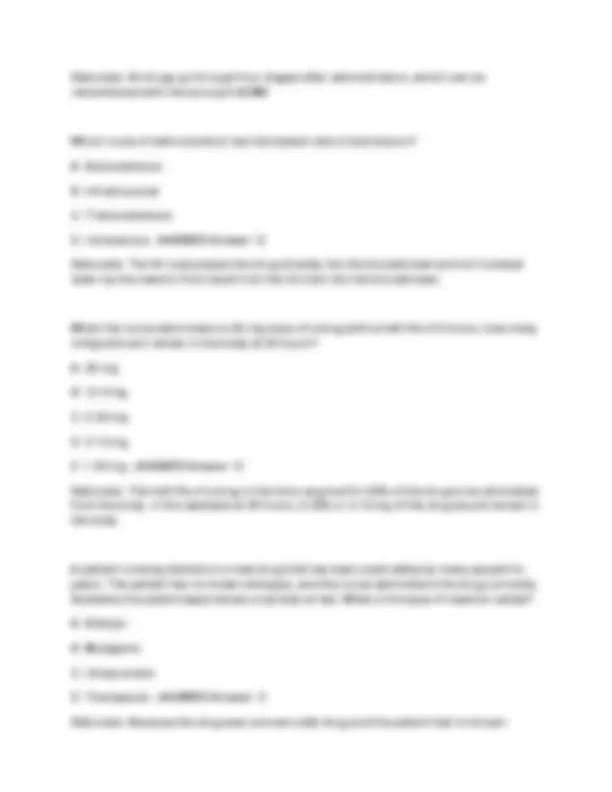
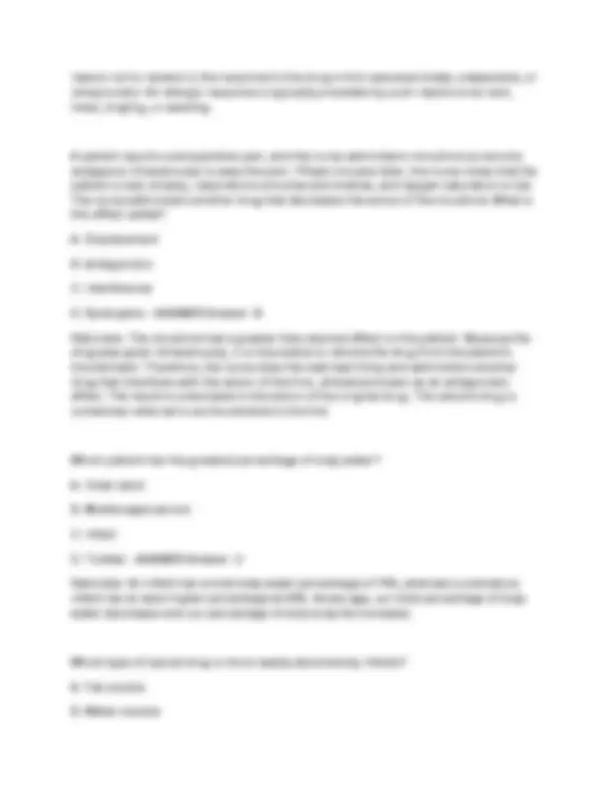
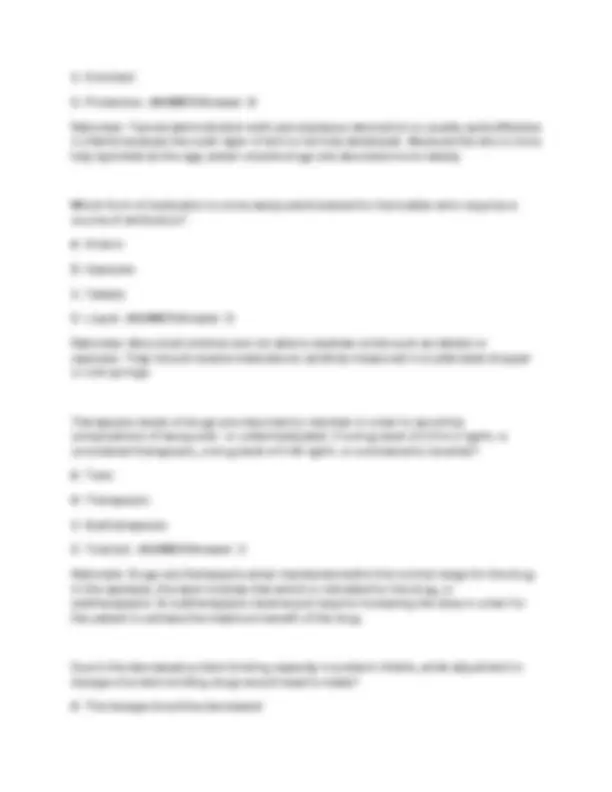
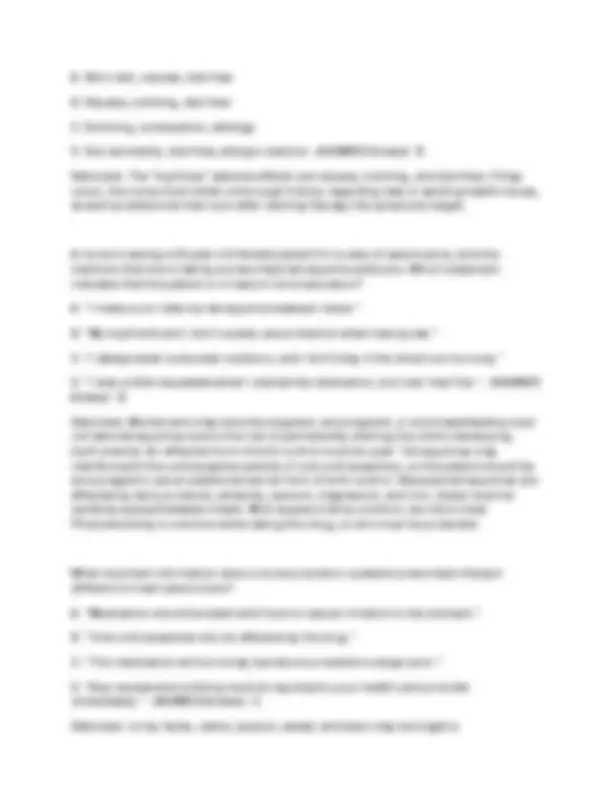
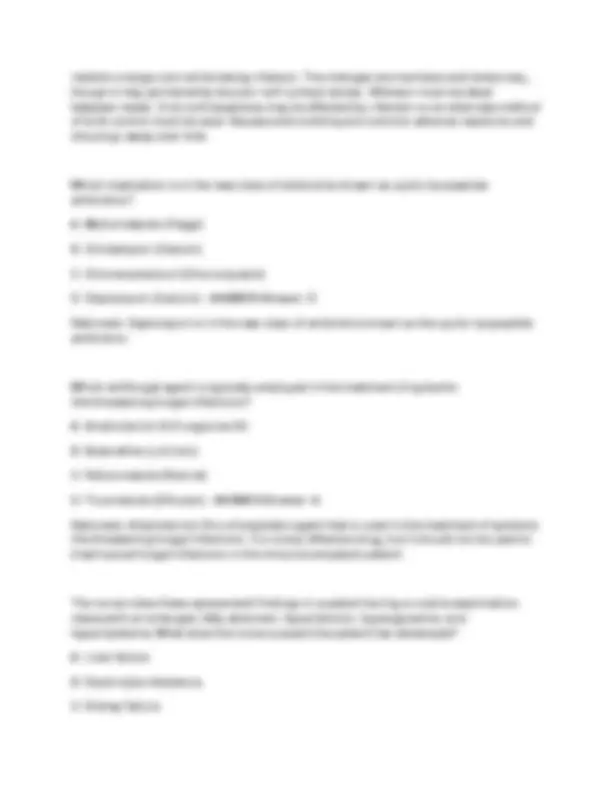
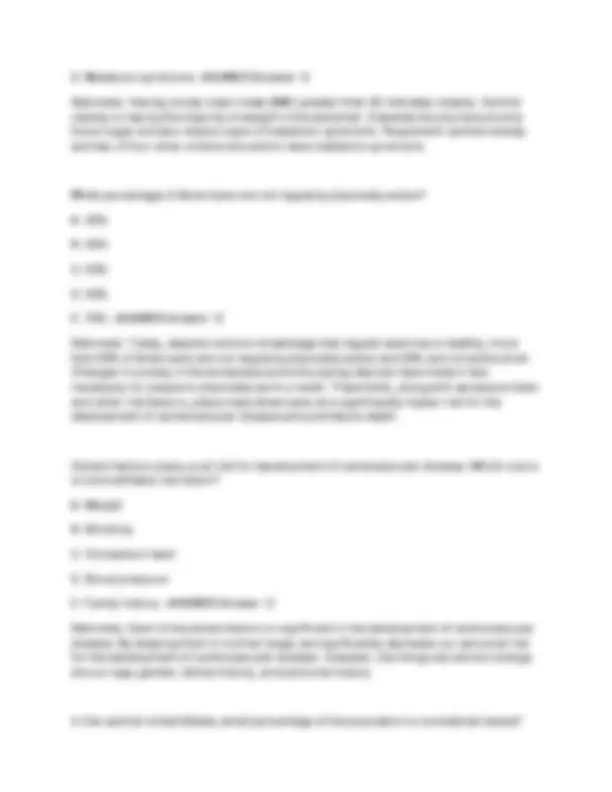
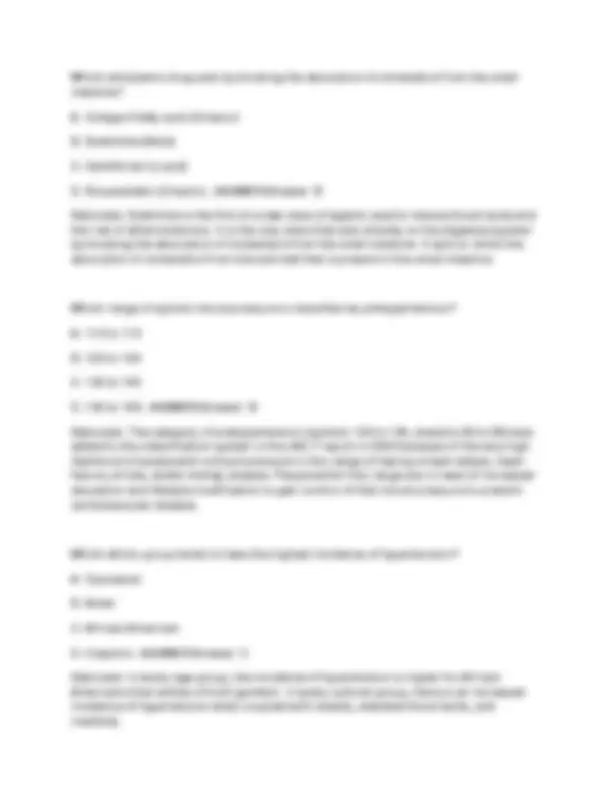
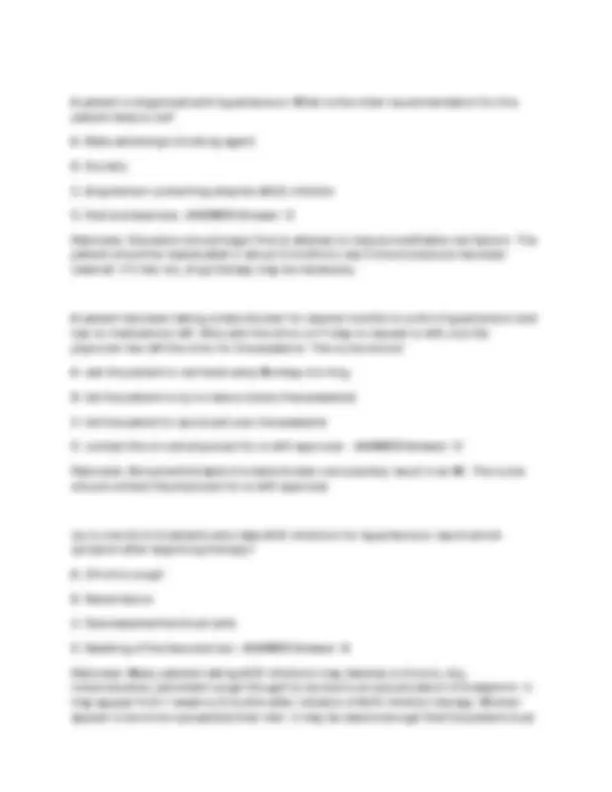
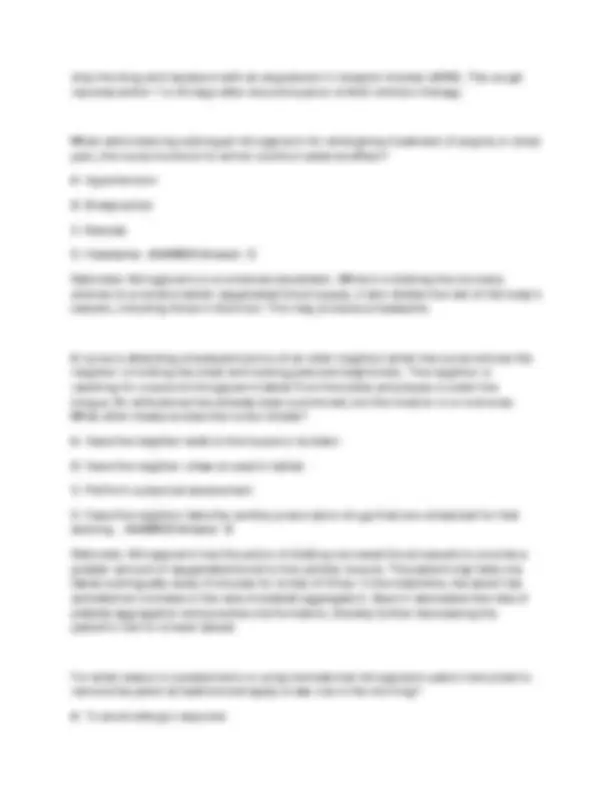
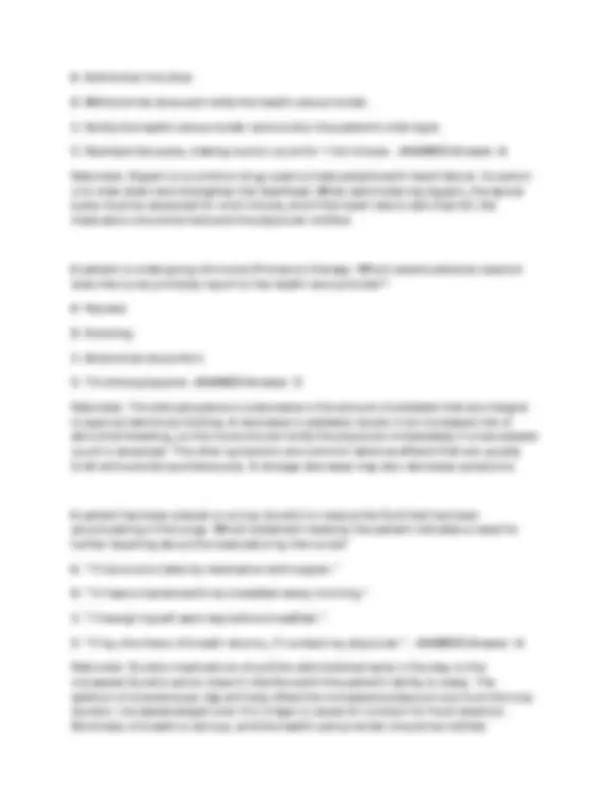
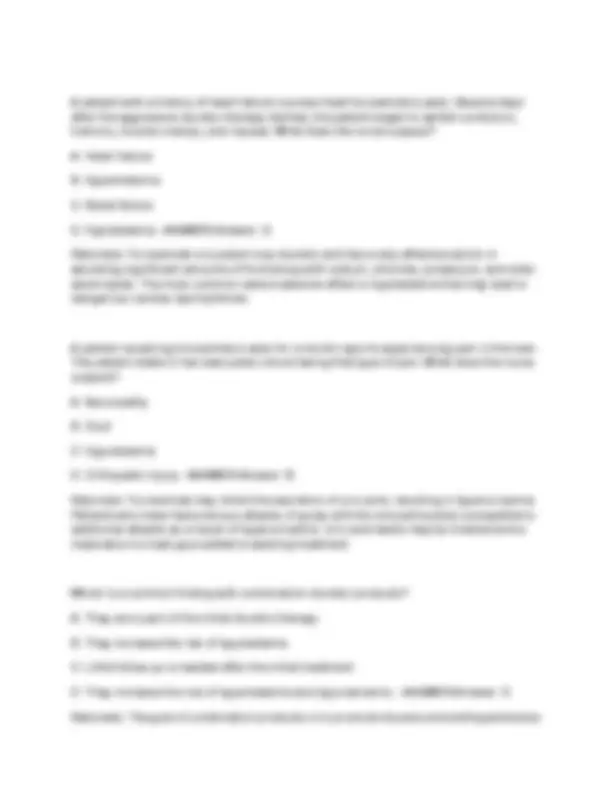
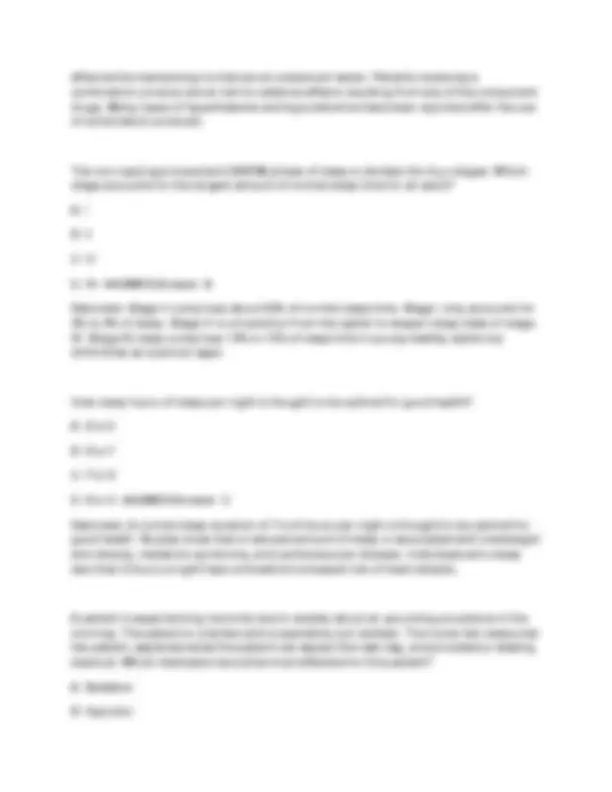
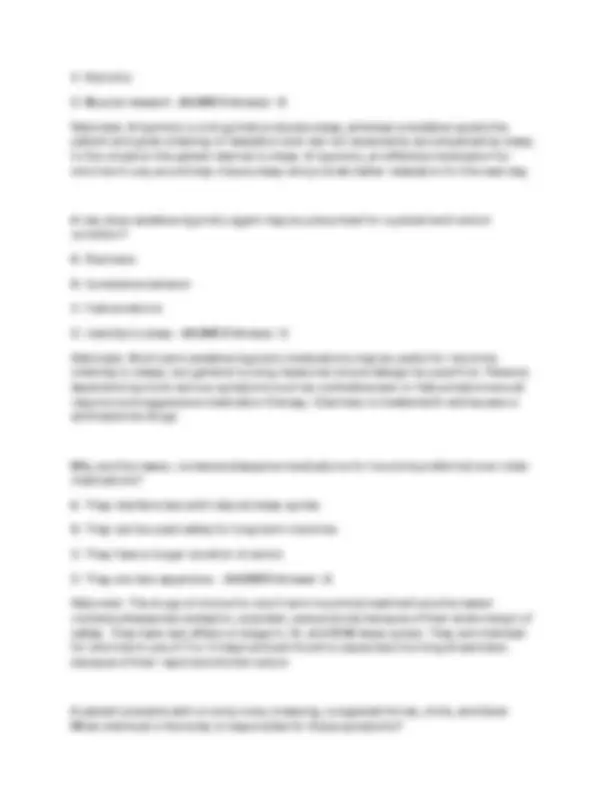
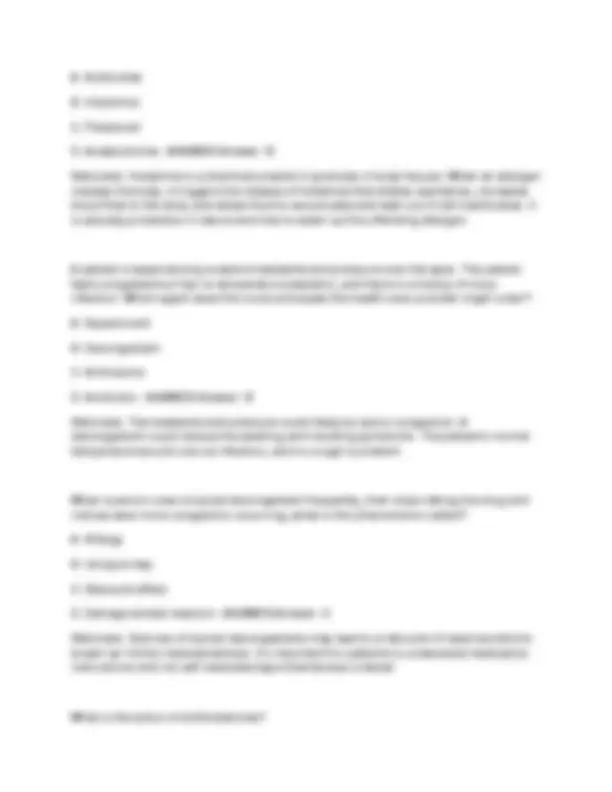
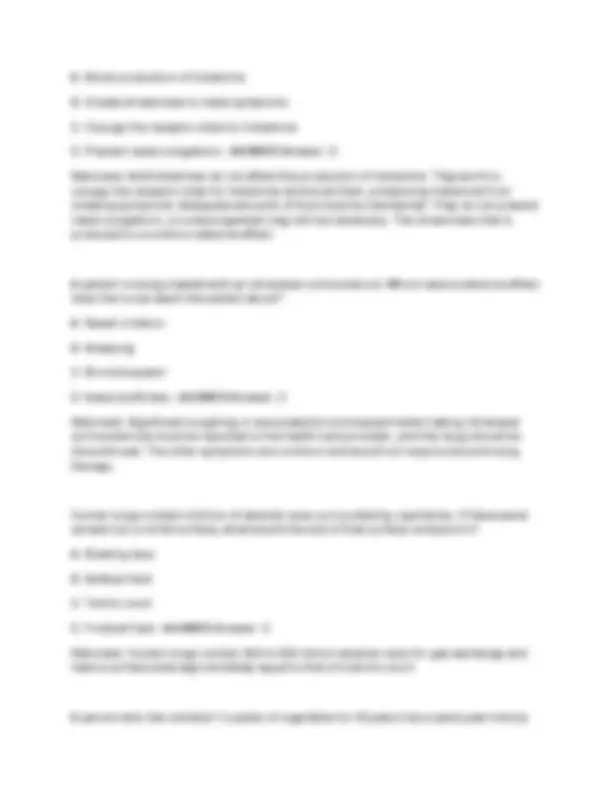
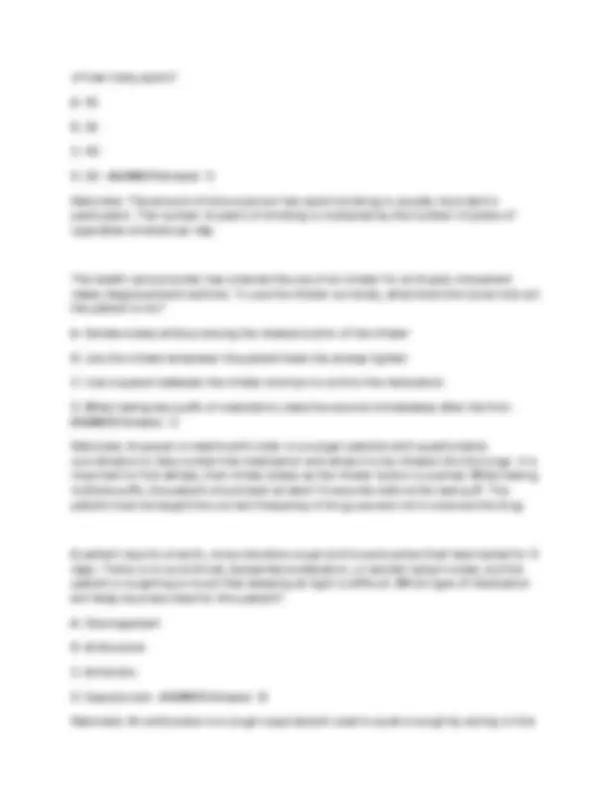
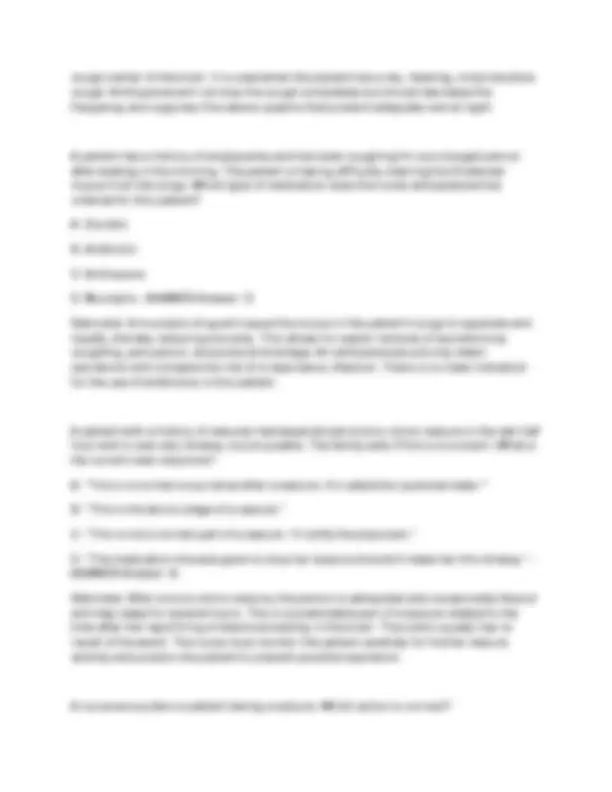
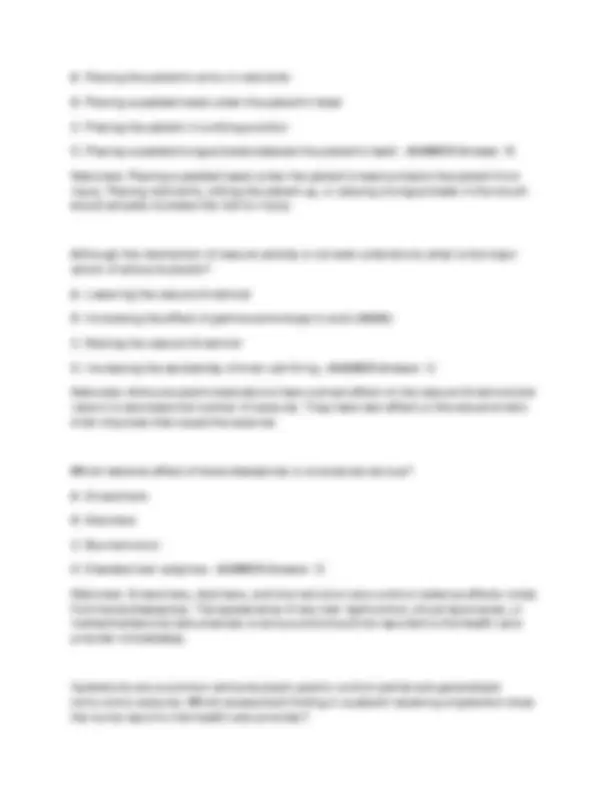
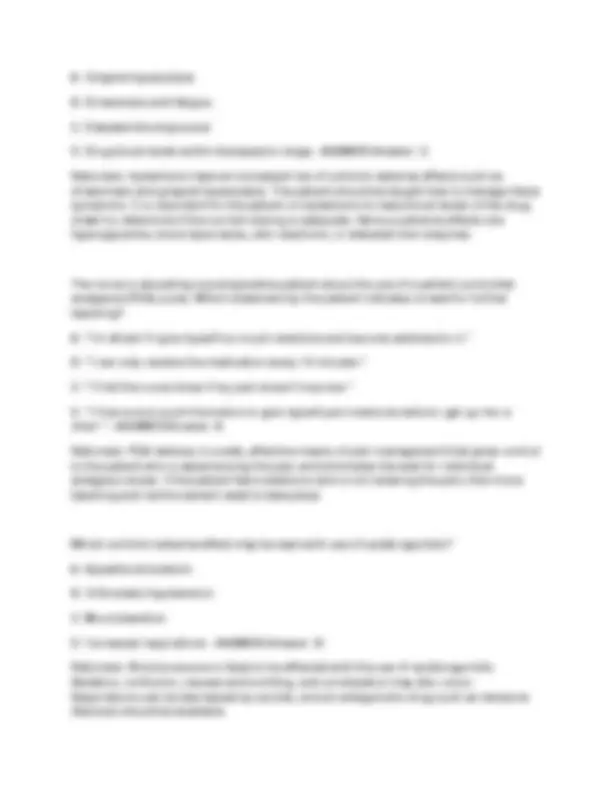
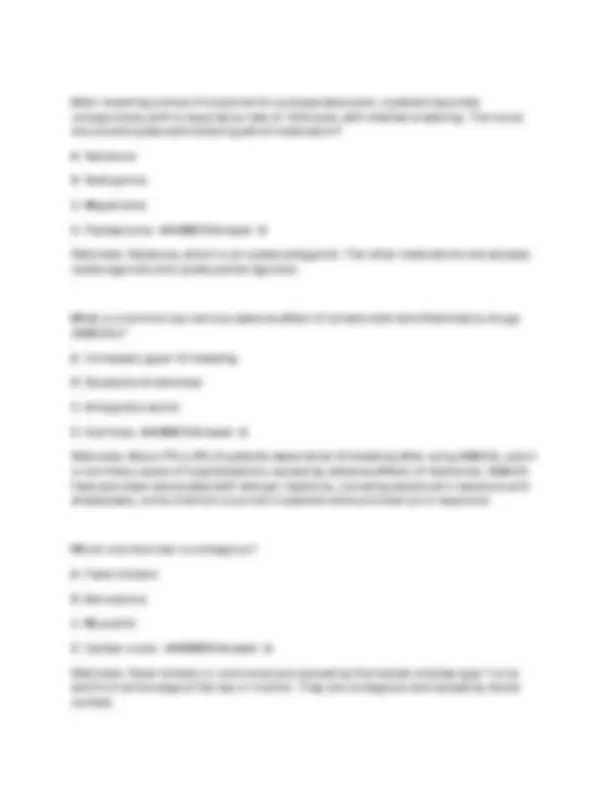
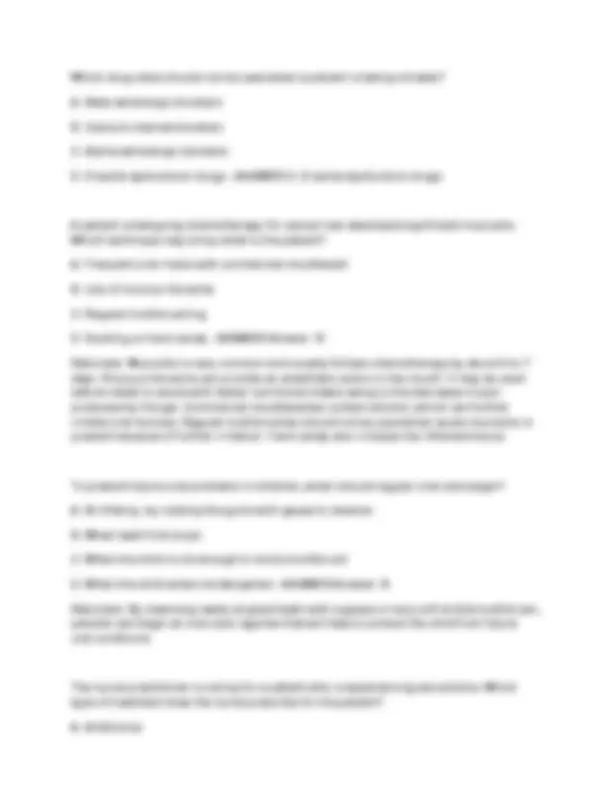
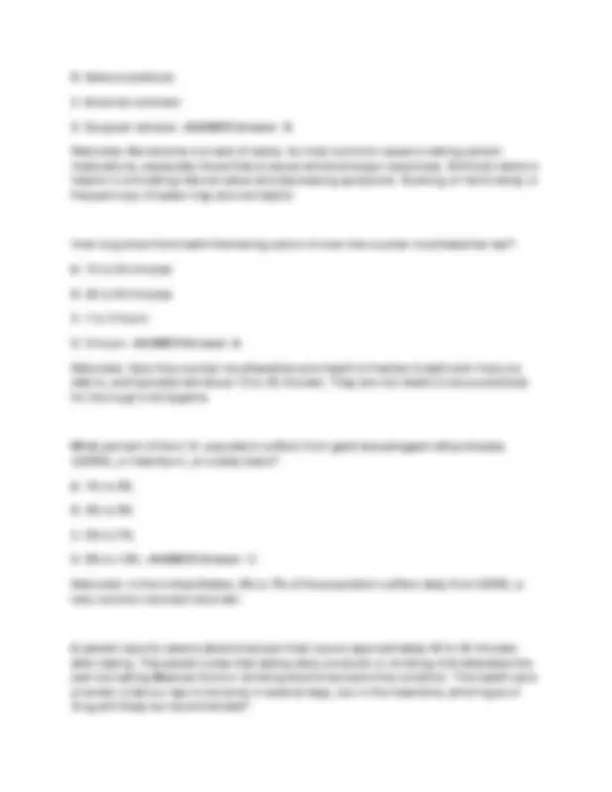
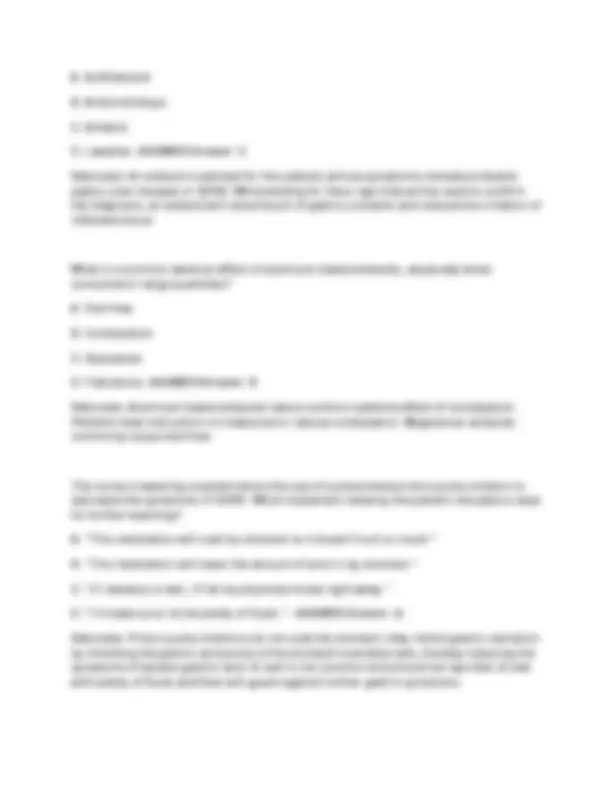
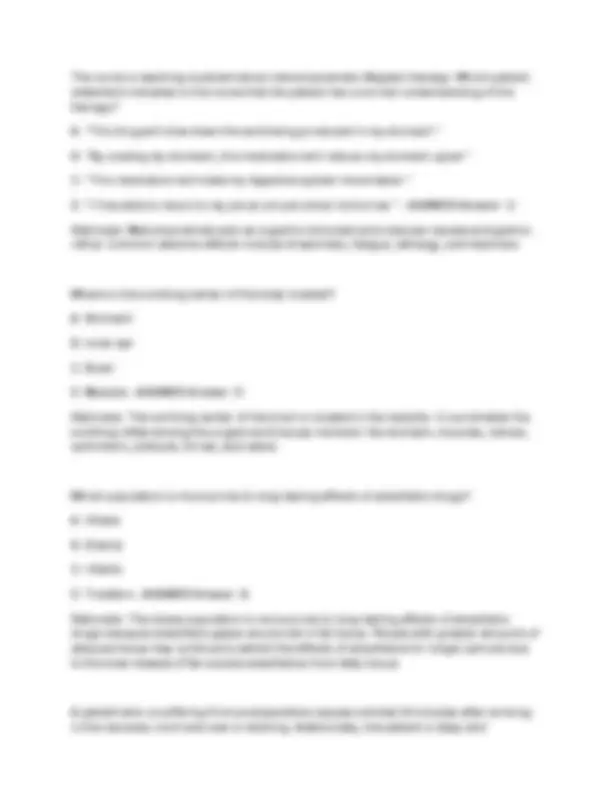
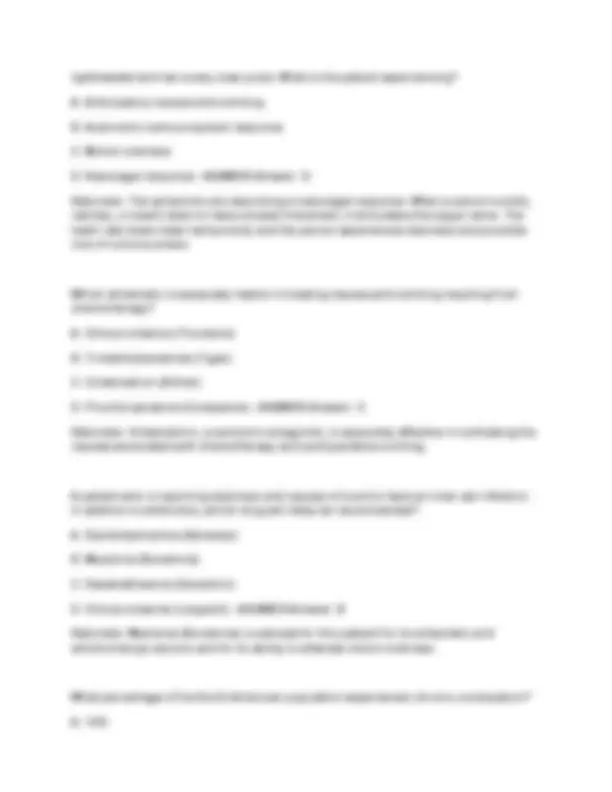
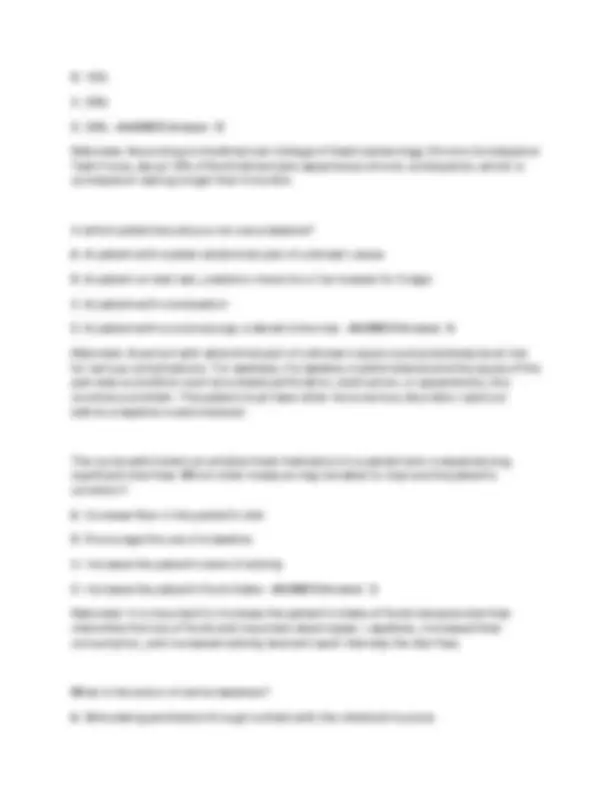
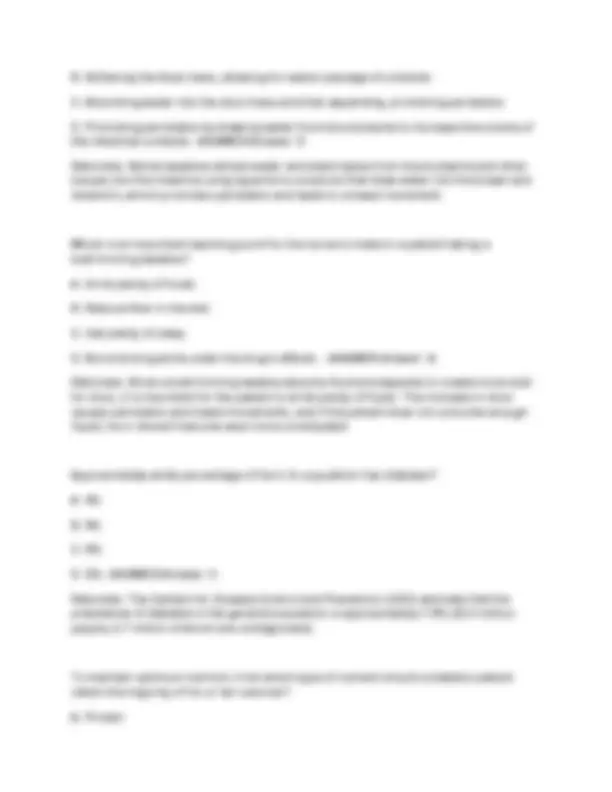
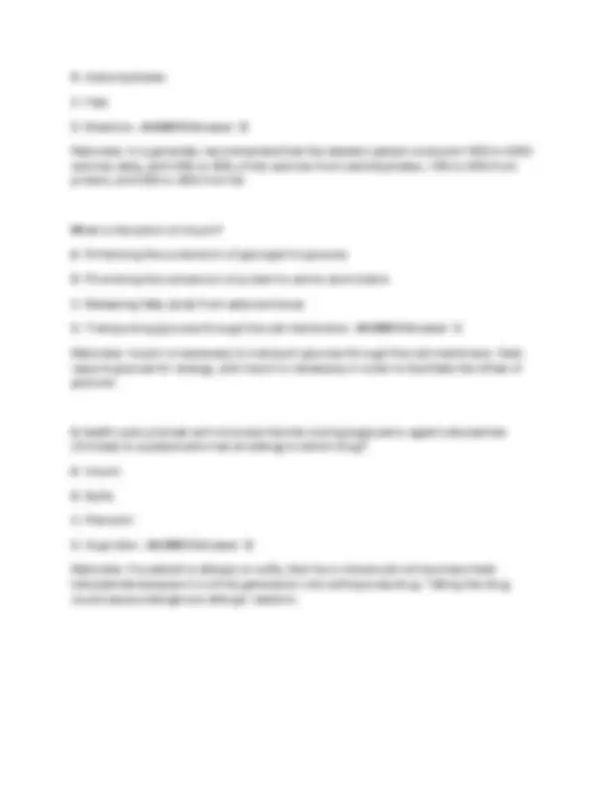


Study with the several resources on Docsity

Earn points by helping other students or get them with a premium plan


Prepare for your exams
Study with the several resources on Docsity

Earn points to download
Earn points by helping other students or get them with a premium plan
Community
Ask the community for help and clear up your study doubts
Discover the best universities in your country according to Docsity users
Free resources
Download our free guides on studying techniques, anxiety management strategies, and thesis advice from Docsity tutors
NURSING 1105 POWERPOINT QUESTIONS AND CORRECT ANSWERS 100% VERIFIED!!
Typology: Exams
1 / 36

This page cannot be seen from the preview
Don't miss anything!





























Which name(s) of a drug should the nurse use when teaching a patient with a new prescription? A. Trade B. Generic and trade C. Generic and chemical D. Official - ANSWER Answer: B Rationale: Drug prescriptions may be filled with a trade-name drug or a generic equivalent. If the nurse teaches only one name, it may lead to confusion for the patient when he or she receives a drug with a different name.
Which source of information is best for the nurse to obtain drug information? A. Physicians' Desk Reference (PDR) B. Nursing journals C. United States Pharmacopeia (USP) and National Formulary (NF) D. Electronic databases - ANSWER Answer: D Rationale: All can be sources of drug information, but keeping information current is extremely important. Reliable electronic databases can provide the most up-to-date information to health care providers, unlike printed resources that are published only periodically.
Which entity is responsible for monitoring drug safety in the United States? A. Drug Enforcement Agency (DEA) B. Department of Justice (DOJ) C. U.S. Food and Drug Administration (FDA)
D. World Health Organization (WHO) - ANSWER Answer: C Rationale: The FDA is responsible for overseeing drug and cosmetic manufacture and promotion to determine their safety before allowing them to be released to the public.
Which drug schedule indicates drugs with the highest risk for abuse? A. Schedule I B. Schedule II C. Schedule III D. Schedule IV E. Schedule V - ANSWER Answer: A Rationale: Schedule I drugs have the highest potential for abuse. They are not currently accepted for medical use in the United States.
How many years on average does it take for a drug to be brought to market from the time of its conception? A. 2 to 3 B. 4 to 7 C. 8 to 15 D. 12 to 18 - ANSWER Answer: C Rationale: It takes 8 to 15 years and can cost up to $1 billion to get a drug to market. This amount of time and money is necessary to adequately test the drug for safety before releasing it to the general population.
All drugs are processed in the body through pharmacokinetics. What is the correct order that drugs pass through the body? A. Absorption, distribution, metabolism, excretion B. Distribution, metabolism, absorption, excretion C. Biotransformation, distribution, absorption, excretion D. Excretion, distribution, absorption, metabolism - ANSWER Answer: A
reason not to receive it, the response to the drug in this case was totally unexpected, or idiosyncratic. An allergic response is typically preceded by such reactions as rash, hives, tingling, or swelling.
A patient reports postoperative pain, and the nurse administers morphine (a narcotic analgesic) intravenously to ease the pain. Fifteen minutes later, the nurse notes that the patient is very drowsy, respirations are slow and shallow, and oxygen saturation is low. The nurse administers another drug that decreases the action of the morphine. What is this effect called? A. Displacement B. Antagonistic C. Interference D. Synergistic - ANSWER Answer: B Rationale: The morphine had a greater-than-desired effect on the patient. Because the drug was given intravenously, it is impossible to remove the drug from the patient's bloodstream. Therefore, the nurse does the next best thing and administers another drug that interferes with the action of the first, otherwise known as an antagonistic effect. The result is a decrease in the action of the original drug. The second drug is sometimes referred to as the antidote to the first
Which patient has the greatest percentage of body water? A. Older adult B. Middle-aged person C. Infant D. Toddler - ANSWER Answer: C Rationale: An infant has a total body water percentage of 74%, whereas a premature infant has an even higher percentage at 83%. As we age, our total percentage of body water decreases and our percentage of total body fat increases.
Which type of topical drug is more readily absorbed by infants? A. Fat-soluble B. Water-soluble
C. Emollient D. Protective - ANSWER Answer: B Rationale: Topical administration with percutaneous absorption is usually quite effective in infants because the outer layer of skin is not fully developed. Because the skin is more fully hydrated at this age, water-soluble drugs are absorbed more readily.
Which form of medication is more easily administered for the toddler who requires a course of antibiotics? A. Enteric B. Capsules C. Tablets D. Liquid - ANSWER Answer: D Rationale: Very small children are not able to swallow solids such as tablets or capsules. They should receive medications carefully measured in a calibrated dropper or oral syringe.
Therapeutic levels of drugs are important to maintain in order to avoid the complications of being over- or undermedicated. If a drug level of 0.5 to 2 ng/mL is considered therapeutic, a drug level of 0.45 ng/mL is considered to be what? A. Toxic B. Therapeutic C. Subtherapeutic D. Tolerant - ANSWER Answer: C Rationale: Drugs are therapeutic when maintained within the normal range for the drug. In this example, the level is below that which is indicated for the drug, or subtherapeutic. A subtherapeutic level would require increasing the dose in order for the patient to achieve the maximum benefit of the drug.
Due to the decreased protein-binding capacity in preterm infants, what adjustment in dosage of protein-binding drugs would need to made? A. The dosage should be decreased.
B. A nursing diagnosis evaluates a patient's response to actual or potential health problems. C. A nursing diagnosis determines the rate of Medicare reimbursement. D. A nursing diagnosis does not consider potential future problems. - ANSWER Answer: B Rationale: A nursing diagnosis takes the form of a three-part statement relating to a patient's response to actual or potential health problems and life processes. It is constantly changing, whereas a medical diagnosis is frequently unchanged during a patient's hospitalization.
Which is an independent nursing action? A. Orders medications based on the patient's medical diagnosis B. Orders laboratory tests depending on the medications ordered C. Chooses an alternate route for medications if indicated D. Verifies the correct route of medication administration - ANSWER Answer: D Rationale: Verification of the correct route of administration is an independent nursing action that is required as part of the "six rights" of administration. Ordering drugs or labs and changing a route of administration are not within the scope of practice for a nurse.
Which piece of information obtained during a patient assessment is a subjective finding? A. Patient states, "I have pain in my abdomen." B. Temperature of 38.5º C C. 400 mL of clear, yellow urine D. Blood pressure of 116/74 mm Hg - ANSWER Answer: A Rationale: A subjective finding is one which the nurse makes using physiologic parameters. A patient's report of pain is a subjective finding because people experience pain differently. An objective assessment is clearly measurable and consistently reportable.
What are the "big three" adverse effects associated with antimicrobial therapy?
A. Skin rash, nausea, diarrhea B. Nausea, vomiting, diarrhea C. Vomiting, constipation, lethargy D. Sun sensitivity, diarrhea, allergic reaction - ANSWER Answer: B Rationale: The "big three" adverse effects are nausea, vomiting, and diarrhea. If they occur, the nurse must obtain a thorough history regarding new or existing health issues, as well as determine how soon after starting therapy the symptoms began.
A nurse is seeing a 20-year-old female patient for a case of severe acne, and she mentions that she is taking a prescribed tetracycline antibiotic. Which statement indicates that the patient is in need of more education? A. "I make sure I take my tetracycline between meals." B. "My boyfriend and I don't usually use protection when having sex." C. "I always wear sunscreen outdoors, and I don't stay in the direct sun too long." D. "I was a little nauseated when I started the medication, but now I feel fine." - ANSWER Answer: B Rationale: Women who may become pregnant, are pregnant, or are breastfeeding must not take tetracyclines due to the risk of permanently staining the child's developing tooth enamel. An effective form of birth control must be used. Tetracyclines may interfere with the contraceptive activity of oral contraceptives, so the patient should be encouraged to use an additional barrier form of birth control. Because tetracyclines are affected by dairy products, antacids, calcium, magnesium, and iron, doses must be carefully spaced between meals. Mild nausea is fairly common, but short-lived. Photosensitivity is common while taking this drug, so skin must be protected.
What important information does a nurse provide to a patient prescribed rifampin (Rifadin) to treat tuberculosis? A. "Medication should be taken with food to reduce irritation to the stomach." B. "Oral contraceptives are not affected by the drug." C. "This medication will turn body secretions a reddish-orange color." D. "Any nausea and vomiting must be reported to your health care provider immediately." - ANSWER Answer: C Rationale: Urine, feces, saliva, sputum, sweat, and tears may be tinged a
D. Metabolic syndrome - ANSWER Answer: D Rationale: Having a body mass index (BMI) greater than 25 indicates obesity. Central obesity is having the majority of weight in the abdomen. Elevated blood pressure and blood sugar are also classic signs of metabolic syndrome. People with central obesity and two of four other criteria are said to have metabolic syndrome.
What percentage of Americans are not regularly physically active? A. 30% B. 40% C. 50% D. 60% E. 70% - ANSWER Answer: D Rationale: Today, despite common knowledge that regular exercise is healthy, more than 60% of Americans are not regularly physically active and 25% are not active at all. Changes in society in the workplace and time-saving devices have made it less necessary for people to physically work or walk. These facts, along with excessive diets and other risk factors, place many Americans at a significantly higher risk for the development of cardiovascular disease and premature death.
Certain factors place us at risk for development of cardiovascular disease. Which one is a nonmodifiable risk factor? A. Weight B. Smoking C. Cholesterol level D. Blood pressure E. Family history - ANSWER Answer: E Rationale: Each of the above factors is significant in the development of cardiovascular disease. By keeping them in normal range, we significantly decrease our personal risk for the development of cardiovascular disease. However, the things we cannot change are our age, gender, family history, and personal history.
In the central United States, what percentage of the population is considered obese?
A. 10% to 14% B. 15% to 19% C. 20% to 24% D. 25% to 29% E. Greater than or equal to 30% - ANSWER Answer: D Rationale: According to the CDC, in 2007 the majority of U.S. states had an obesity rate of 25% to 29%. Only one state (Colorado) had an obesity rate less than 20%. Three states (Tennessee, Alabama, Mississippi) had a prevalence of obesity equal to or greater than 30%.
To decrease the risk of cardiovascular disease in patients, which measure is recommended by health care professionals? A. Increase intake of saturated fats B. Increase HDL cholesterol levels C. Increase triglyceride levels D. Increase LDL cholesterol levels - ANSWER Answer: B Rationale: The latest report from the Academy of Sciences (2002) stresses the importance of balancing diet with physical activity to improve circulation, increase HDL levels, and burn calories. Most dietary fat should be unsaturated.
Which is the most favorable lipid level? A. Elevated low-density lipoprotein (LDL) B. Decreased high-density lipoprotein (HDL) C. Elevated HDL D. Elevated triglycerides - ANSWER Answer: C Rationale: The combination of elevated LDL and triglycerides and decreased HDL levels greatly increase one's risk of developing metabolic syndrome and many types of cardiovascular disease. Treatment of dyslipidemia is generally to lower the triglycerides and LDL and raise HDL.
What percentage of our daily total caloric intake should be limited to carbohydrates?
Which antilipemic drug acts by blocking the absorption of cholesterol from the small intestine? A. Omega-3 fatty acid (Omacor) B. Ezetimibe (Zetia) C. Gemfibrozil (Lopid) D. Rosuvastatin (Crestor) - ANSWER Answer: B Rationale: Ezetimibe is the first of a new class of agents used to reduce blood lipids and the risk of atherosclerosis. It is the only class that acts directly on the digestive system by blocking the absorption of cholesterol from the small intestine. It acts to inhibit the absorption of cholesterol from bile and diet that is present in the small intestine.
Which range of systolic blood pressure is classified as prehypertension? A. 110 to 119 B. 120 to 139 C. 130 to 149 D. 140 to 159 - ANSWER Answer: B Rationale: The category of prehypertension (systolic 120 to 139, diastolic 80 to 89) was added to the classification system in the JNC 7 report in 2003 because of the very high likelihood of people with a blood pressure in this range of having a heart attack, heart failure, stroke, and/or kidney disease. People within this range are in need of increased education and lifestyle modification to gain control of their blood pressure to prevent cardiovascular disease.
Which ethnic group tends to have the highest incidence of hypertension? A. Caucasian B. Asian C. African American D. Hispanic - ANSWER Answer: C Rationale: In every age group, the incidence of hypertension is higher for African Americans than whites of both genders. In every cultural group, there is an increased incidence of hypertension when coupled with obesity, elevated blood lipids, and inactivity.
A patient is diagnosed with hypertension. What is the initial recommendation for this patient likely to be? A. Beta-adrenergic blocking agent B. Diuretic C. Angiotensin-converting enzyme (ACE) inhibitor D. Diet and exercise - ANSWER Answer: D Rationale: Education should begin first to attempt to reduce modifiable risk factors. The patient should be reevaluated in about 2 months to see if blood pressure has been lowered. If it has not, drug therapy may be necessary.
A patient has been taking a beta blocker for several months to control hypertension and has no medications left. She calls the clinic on Friday to request a refill, but the physician has left the clinic for the weekend. The nurse should: A. ask the patient to call back early Monday morning. B. tell the patient to try to have a stress-free weekend. C. tell the patient to avoid salt over the weekend. D. contact the on-call physician for a refill approval. - ANSWER Answer: D Rationale: Abrupt withdrawal of a beta blocker can possibly result in an MI. The nurse should contact the physician for a refill approval.
Up to one-third of patients who take ACE inhibitors for hypertension report which symptom after beginning therapy? A. Chronic cough B. Renal failure C. Decreased white blood cells D. Swelling of the face and lips - ANSWER Answer: A Rationale: Many patients taking ACE inhibitors may develop a chronic, dry, nonproductive, persistent cough thought to be due to an accumulation of bradykinin. It may appear from 1 week to 6 months after initiation of ACE inhibitor therapy. Women appear to be more susceptible than men. It may be severe enough that the patient must
B. To prevent overdosage C. To prevent tolerance D. To prevent the patient from forgetting to remove the patch in the morning - ANSWER Answer: C Rationale: Tolerance develops fairly quickly when nitroglycerin is applied for 24 hours daily. By removing it from the skin during the night when activity levels are low, the patient has less need for the effects of the drug.
Which drug class should not be used when a patient is taking nitrates? A. Beta-adrenergic blockers B. Calcium channel blockers C. Alpha-adrenergic blockers D. Erectile dysfunction drugs - ANSWER Answer: D Rationale: The action of erectile dysfunction drugs is to dilate blood vessels. If these drugs and nitrates are used together, it could cause dangerously low blood pressure and loss of consciousness.
A nurse is reviewing core measures in charts of patients who have been discharged following an acute MI. The nurse should ensure patients are discharged home with which medication? A. Calcium channel blocker B. Beta adrenergic blocker C. Intravenous nitroglycerin D. Amiodarone (Pacerone) - ANSWER Answer: B Rationale: Beta-adrenergic blockers should be given to patients who are discharged following an MI.
A patient has been recently diagnosed with heart failure due to systolic dysfunction. She asks the nurse to explain the disease process to family members. The best explanation is: A. "The heart rate is failing to keep up with the body's needs."
B. The patient has developed dysrhythmias that have failed to respond to medication." C. "The heart does not have adequate force to pump all needed blood." D. "The left ventricle fails to relax enough between beats to fill with blood." - ANSWER Answer: C Rationale: Systolic heart failure results when the heart lacks sufficient force to pump all the blood to meet the body's oxygenation needs. Diastolic heart failure is caused by "stiffness" and the inability to relax enough between contractions to allow adequate filling. Heart rate and rhythm issues are not indicators of systolic heart failure.
A patient has presented to the emergency department reporting feeling short of breath. What other symptom alerts the nurse that the patient may be in heart failure? A. Lungs clear to auscultation B. 2+ ankle edema C. BP 118/74 mm Hg D. Stable weight - ANSWER Answer: B Rationale: The presence of significant ankle edema indicates possible heart failure when coupled with crackles in the lungs, weight gain of 2 or more pounds in 2 days, and chest pain or shortness of breath. These symptoms develop because the heart is not pumping strongly enough to pull excess fluid into the bloodstream.
Digoxin (Lanoxin) is a cardiac glycoside that is among the oldest medications used for heart failure. What are its two primary actions? A. Negative inotropy and negative chronotropy B. Positive inotropy and negative chronotropy C. Negative chronotropy and positive dromotropy D. Positive chronotropy and negative inotropy - ANSWER Answer: B Rationale: Digoxin exhibits positive inotropic activity in that it increases the contractility of the cardiac muscle. It also exhibits a negative chronotropic activity in that it decreases the heart rate.
The nurse is preparing a patient's daily dose of digoxin (Lanoxin), an inotropic drug. The patient has an apical pulse of 68/min. What should the nurse do next?
A patient with a history of heart failure is prescribed furosemide (Lasix). Several days after the aggressive diuretic therapy started, the patient began to exhibit confusion, tremors, muscle cramps, and nausea. What does the nurse suspect? A. Heart failure B. Hyperkalemia C. Renal failure D. Hypokalemia - ANSWER Answer: D Rationale: Furosemide is a potent loop diuretic and has a very effective action in excreting significant amounts of fluid along with sodium, chloride, potassium, and other electrolytes. The most common severe adverse effect is hypokalemia that may lead to dangerous cardiac dysrhythmias.
A patient receiving furosemide (Lasix) for a month reports experiencing pain in the toes. The patient states it has been years since having that type of pain. What does the nurse suspect? A. Neuropathy B. Gout C. Hypokalemia D. Orthopedic injury - ANSWER Answer: B Rationale: Furosemide may inhibit the excretion of uric acid, resulting in hyperuricemia. Patients who have had previous attacks of gouty arthritis are particularly susceptible to additional attacks as a result of hyperuricemia. Uric acid levels may be ordered and a medication to treat gout added to existing treatment.
Which is a common finding with combination diuretic products? A. They are a part of the initial diuretic therapy. B. They increase the risk of hypokalemia. C. Little follow-up is needed after the initial treatment. D. They increase the risk of hyperkalemia and hyponatremia. - ANSWER Answer: D Rationale: The goal of combination products is to promote diuresis and antihypertensive
effect while maintaining normal serum potassium levels. Patients receiving a combination product are at risk for adverse effects resulting from any of the component drugs. Many cases of hyperkalemia and hyponatremia have been reported after the use of combination products.
The non-rapid eye movement (NREM) phase of sleep is divided into four stages. Which stage accounts for the largest amount of normal sleep time for an adult? A. I B. II C. III D. IV - ANSWER Answer: B Rationale: Stage II comprises about 50% of normal sleep time. Stage I only accounts for 2% to 5% of sleep. Stage III is a transition from the lighter to deeper sleep state of stage IV. Stage IV sleep comprises 10% to 15% of sleep time in young healthy adults but diminishes as a person ages.
How many hours of sleep per night is thought to be optimal for good health? A. 5 to 6 B. 6 to 7 C. 7 to 8 D. 8 to 9 - ANSWER Answer: C Rationale: A normal sleep duration of 7 to 8 hours per night is thought to be optimal for good health. Studies show that a reduced amount of sleep is associated with overweight and obesity, metabolic syndrome, and cardiovascular disease. Individuals who sleep less than 5 hours a night have a threefold increased risk of heart attacks.
A patient is experiencing insomnia due to anxiety about an upcoming procedure in the morning. The patient is oriented and cooperative, but restless. The nurse has reassured the patient, explained what the patient can expect the next day, and provided a relaxing backrub. Which medication would be most effective for this patient? A. Sedative B. Hypnotic